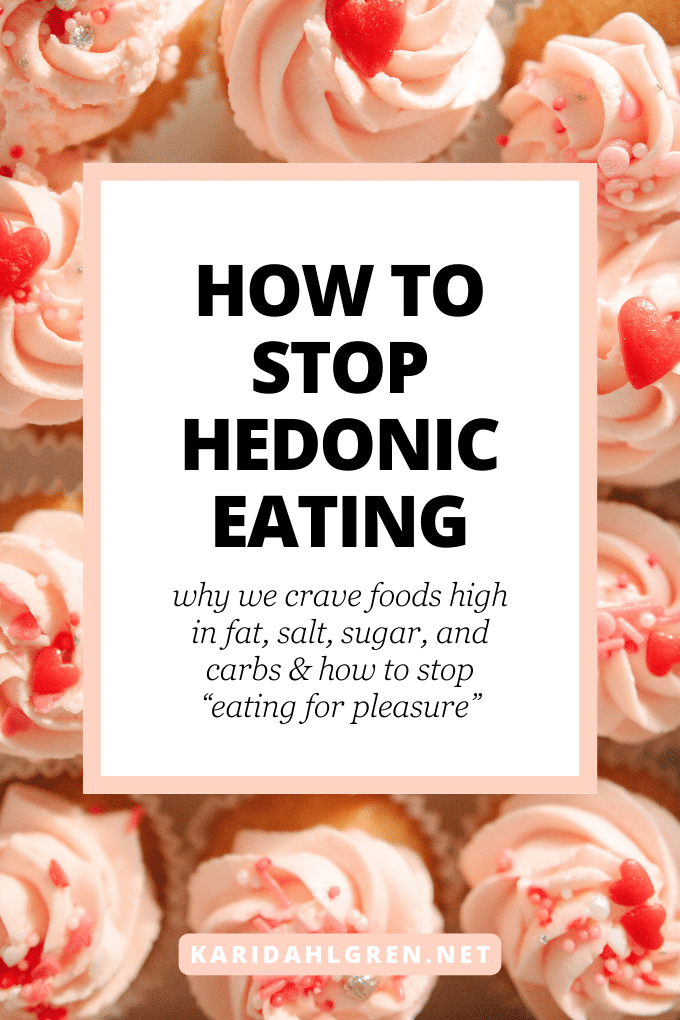
Hedonic eating describes the experience of reaching for food not out of hunger but for pleasure. Reaching for foods high in fat, salt, sugar, or carbohydrates (“hyper-palatable” or “hedonic” foods) can be a symptom of this type of emotional eating.
When we think of emotional eating, we often think of buffering negative emotions with food; but emotional eating is also sometimes motivated by positive emotions.[1] In my experience recovering from compulsive eating and as an eating psychology coach, hedonic eating can involve both: a drive to avoid negative emotion while adding the positive, feel-good rush of dopamine.
In this guide, we’ll unpack hedonic eating and hedonic hunger with plenty of clinical evidence. We’ll also unpack the process of learning how to stop eating for pleasure through specific steps rooted in eating psychology, which is my area of expertise.
What Is Hedonic Eating?
The root word of “hedonic” is “hedon,” which comes from the Greek word “hēdonē,” meaning “pleasure” or “delight.” Therefore, hedonic eating is the act of eating for pleasure rather than for hunger or true caloric needs.[2] It could be the satisfying, salty crunch of potato chips or the silky-smooth mouthfeel of chocolate. If it’s high-calorie, it’s probably hedonic.
Before we go any further, it’s important to know that eating pleasure is not bad, and it actually promotes healthy eating.[3] Canada and Brazil have even included eating pleasure in their latest dietary guidelines as a healthy eating recommendation. This article seeks to address eating pleasure when it becomes compulsive, where eating goes beyond the boundaries of hunger and fullness.
Understanding Hedonic Eating: 5 Evidence-Based Reasons Why We Eat for Pleasure
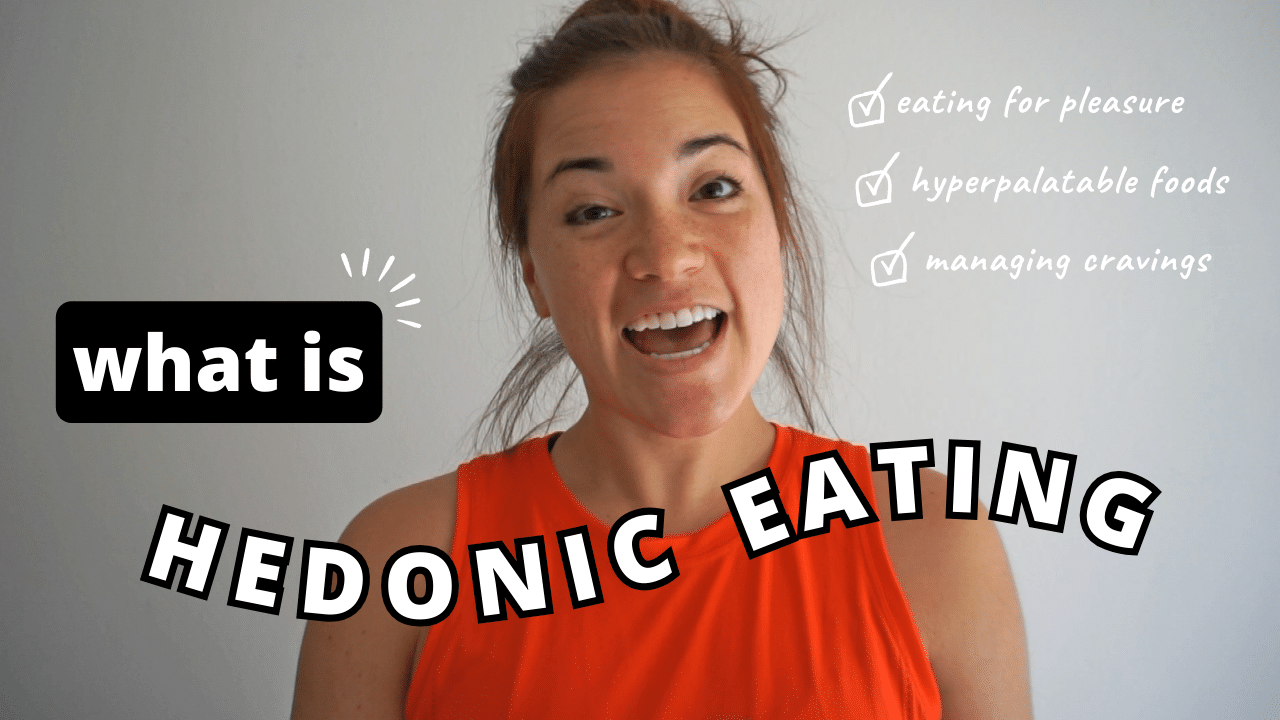
In my YouTube video above, I discuss what hedonic eating is and, more importantly, why you don’t need to feel powerless to food addiction. Although hedonic foods have been shown to possesses addicting qualities — the phenomenon behind the emerging theory of food addiction[4] — eating psychology serves as a powerful and often underrated path forward.
Before we unpack the steps for learning how to stop eating for pleasure, let’s unravel all the reasons why hedonic eating has become a common human experience.
1. Hedonic Eating Is Influenced by Reward Circuitry and Food Addiction
Hedonic eating triggers the release of dopamine, a neurotransmitter associated with pleasure and reward. The dopamine surge after consuming hyperpalatable foods (think: the “sugar high” after eating sweets) reinforces the desire for them and may foster a cycle of compulsive eating.[5]
Hyperpalatable foods can also alter brain areas associated with reward and pleasurable experiences, much like the changes seen in drug addiction.[6], [7] Despite the similarities, food addiction should not be equated with drug addiction due to food’s essential role in survival, making any direct comparison overly simplistic.[8]
Food addiction is a controversial concept with some studies supporting it and other studies stating a need for more evidence.[9], [10], [11] Still, the compulsive behaviors of food addiction include measurable addiction-like behaviors based on the Yale Food Addiction Score, affecting 10-25% of the population.[5] Addiction-like behaviors in eating are a common experience, and increasing awareness helps pave the way towards change.
2. Hormones and Peptides Reinforce the Desire to “Eat for Pleasure”
Hedonic eating is also influenced by certain hormones and peptides — especially those associated with pleasure. One notable player is ghrelin, often referred to as the “hunger hormone,” which is primarily associated with appetite regulation. Studies reveal that hedonic foods increase ghrelin.[12]
This indicates that as cravings for pleasurable foods heighten, they intensify both physical hunger and emotional hunger, making it harder to distinguish between the two.
It’s also important to understand the endocannabinoid system, where a complex network of receptors, enzymes, and compounds help regulate appetite, mood, and pleasure. One study found that eating pleasure causes both ghrelin and 2-AG, an endocannabinoid associated with appetite and pleasure, to rise.[12] This highlights the overlap between the biological and psychological factors behind our eating habits.
3. Hedonic Eating Involves Seeking Pleasure and Avoiding Stress
While hedonic eating is strongly linked with pleasure and the desire for a feel-good “dopamine hit,” it’s also influenced by negative emotions like stress. The release of stress hormones like cortisol can alter our food choices, pushing us towards high-reward, hedonic foods as a coping mechanism to alleviate negative emotions and enhance mood.[13]
This is where a silver lining surprisingly emerges.
Recent studies show that eating in response to negative emotions correlates with poorer psychological outcomes while eating for pleasure — tied to positive emotions — shows no significant negative impacts.[14]
This highlights that not all emotional eating is harmful. Pleasure-driven eating associated with hedonic habits may carry fewer psychological risks. This also supports the emerging importance of pleasure in healthy eating.[3]
Of course, this applies to pleasurable eating within the boundaries of hunger and fullness. If you struggle with hedonic eating beyond comfortable fullness, then it becomes appropriate to learn how to stop eating for pleasure — with the goal of honoring one’s internal body cues.
4. Hyper-Palatable Foods Are Hyper-Available
Another hurdle with hedonic eating is the prevalence and engineered irresistibility of hedonic foods. For instance, McDonalds’ Grand Mac not only boasts 850 calories but also includes 9 grams of unnecessary sugar simply to increase its allure and trigger the brain’s reward circuits.
Neuroimaging studies highlight that the immediate availability of such high-calorie, hyperpalatable foods significantly boosts their palatability and stimulates brain areas associated with reward and motivation.[15] Accessibility indeed has an impact on our eating behaviors.
Again, while the science behind food addiction is emerging, you don’t need to feel powerless to McDonalds’ golden arches. In my work as an eating psychology coach, I’ve found that understanding and addressing the psychological roots of our eating habits can make even the most tempting foods resistible when you aren’t hungry:

Dive deeper into eating psychology: If you relate to hedonic eating, take my quiz to discover your eating psychology strength. Even if you constantly feel tempted around hedonic food, we all have a strength — and I would love to help you build upon yours.
5. Dieting Doesn’t Work — It Only Amplifies Hedonic Hunger
Attempting to resist hedonic foods to learn how to stop eating for pleasure seldom works. Restriction induces a sense of scarcity and deprivation, triggering biological and psychological responses that ironically increase craving for high-calorie, hyperpalatable foods.
Brain scan studies reveal that trying to avoid eating (dietary restraint) activates brain areas linked to avoidance behaviors, while cravings for pleasurable foods (hedonic hunger) activates regions tied to indulgence, such as binge eating.[16]
These findings indicate that even when people try to control their eating, a powerful brain response to pleasurable foods often dominates, demonstrating the difficulty of managing eating habits through restraint alone. This suggests a need for strategies beyond simple self-control to effectively handle eating behaviors.
How to Stop Eating for Pleasure: Psychology Holds the Cure for Hedonic Eating
While hedonic hunger and food addiction are biological phenomena, there are powerful psychological undercurrents that, when carefully redirected, can help pave the way towards balanced eating. Restricting hyperpalatable foods clearly doesn’t work, so let’s dive into some tips rooted in eating psychology.
Here are some evidence-based steps for learning how to stop eating for pleasure:
Cultivate Joy and Pleasure Beyond Food

Hedonic eating often stems from a desire to experience pleasure and satisfaction. When joy and life satisfaction are lacking, it can increase the likelihood of turning to food for happiness. To learn how to stop eating for pleasure, it’s important to nurture pleasure elsewhere in your life outside of food.
One small study found that higher life satisfaction correlated with reduced consumption of commonly craved foods.[17] By actively nurturing activities, relationships, and experiences that bring you joy, you can reduce the tendency, if any, to use food for emotional fulfillment.
Normalize Hedonic Foods to Diminish Their Allure
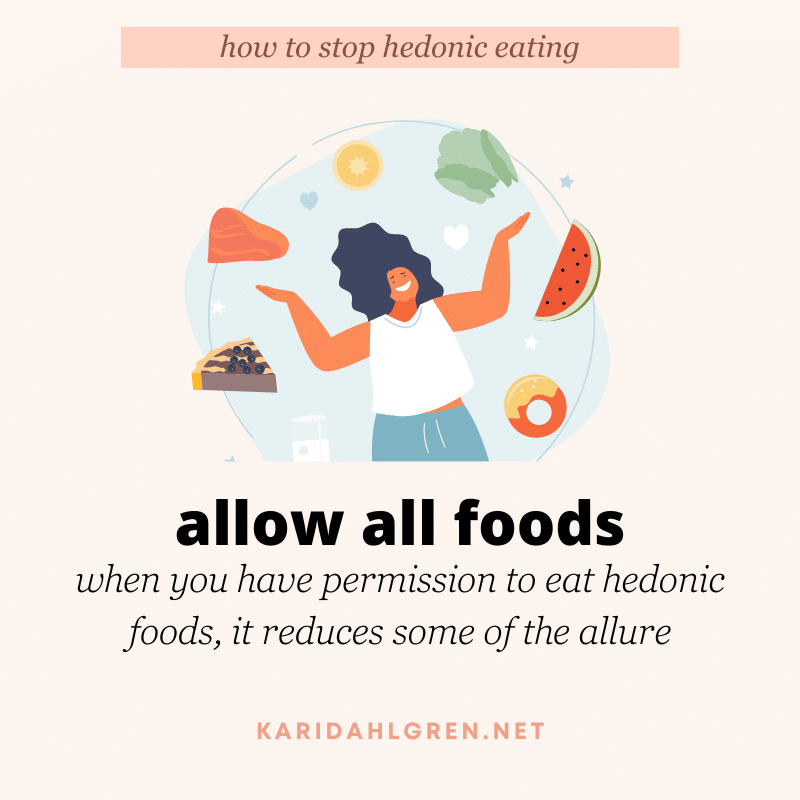
Eating pleasure is a healthy eating recommendation[3] and all foods truly can fit into a balanced diet, even a Grand Mac at times. A problem emerges, however, when we place hyperpalatable foods off-limits, which increases the time we spend thinking about them, and it makes us crave them even more.[18]
Have you ever been there, placing sweets off-limits only to think about them more often — like after lunch, during the 2pm slump, and every single minute between dinner and bedtime? This is the reverse psychology of restriction, and it can be equally effective when flipped on its head. When all foods are allowed, it diminishes the “forbidden fruit” allure of hedonic foods.
If you’re afraid of gaining weight by allowing yourself to eat the foods that you enjoy, see my YouTube video below:

Do you believe that your weight can stabilize if you only eat when you’re hungry, enjoy the foods that truly appeal to you — even if they’re hyperpalatable — and stop when you’re full? Not only does research support this (see: set point weight theory) but it also intuitively feels right, doesn’t it?
Of course, stopping when you’re full can be the hardest part for anyone with a history of compulsive eating, and the next step will address that hurdle. Because behind every desire to eat without hunger is an uncomfortable emotion that needs your attention.
Address the Root of Emotional Eating
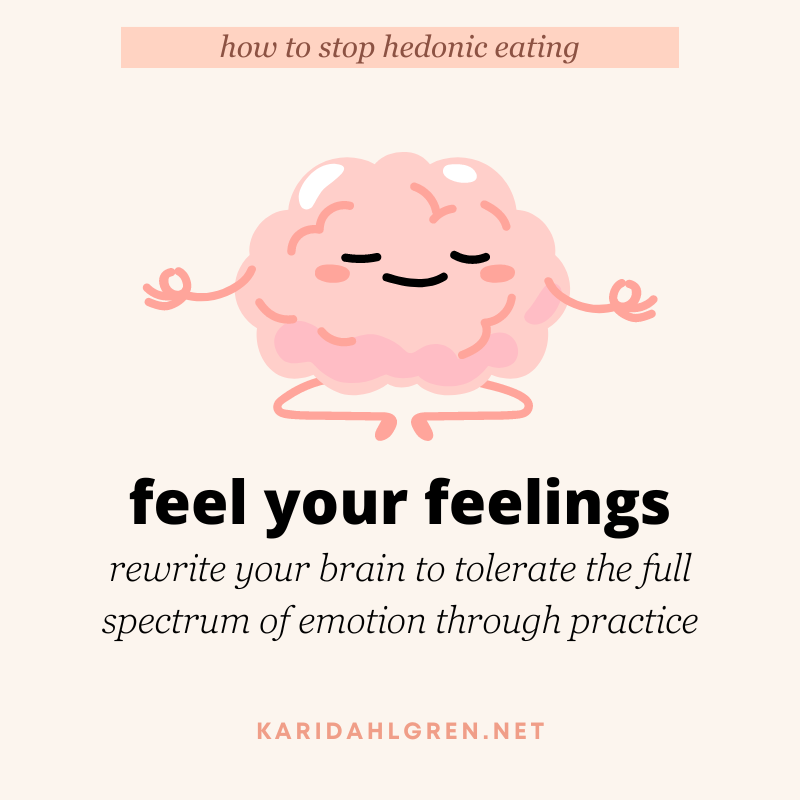
If you need help stopping at fullness when you’re in the grips of hedonic eating — which is a common experience as hyperpalatable foods are engineered to be irresistible — my Stop, Drop, & Feel method can help.
To use this technique, identify the moment that you want to eat beyond fullness and briefly step away. Promise yourself that you can continue eating after the SDF if that’s what you really want. This prevents the Stop, Drop, & Feel from triggering the restrict-binge cycle. Then, drop into whatever feelings arise without judgment and allow yourself to fully feel your emotions.
By training in sitting still with uncomfortable emotions, you develop emotional tolerance, the ability to withstand discomfort without reaching for a buffer.
Emotional tolerance is a skill associated with reduced overeating tendencies.[19]
When you’re able to handle the uncomfortable emotions that life hands you, you’ll be less inclined to search for comfort in food. Whether it’s eating out of negative emotion or eating for pleasure, if you’re reaching for hedonic foods without the presence of hunger, it’s hedonic eating, and you can cure the pattern by sharpening emotional self-regulation skills.
It’s a psycho-spiritual journey: Eating psychology is powerful, and learning to feel your feelings can open a doorway to spiritual growth. Learn more in my free ebook, The Spiritual Seeker’s Guide to Stop Binge Eating.
Identify Any Limiting Beliefs Around Food
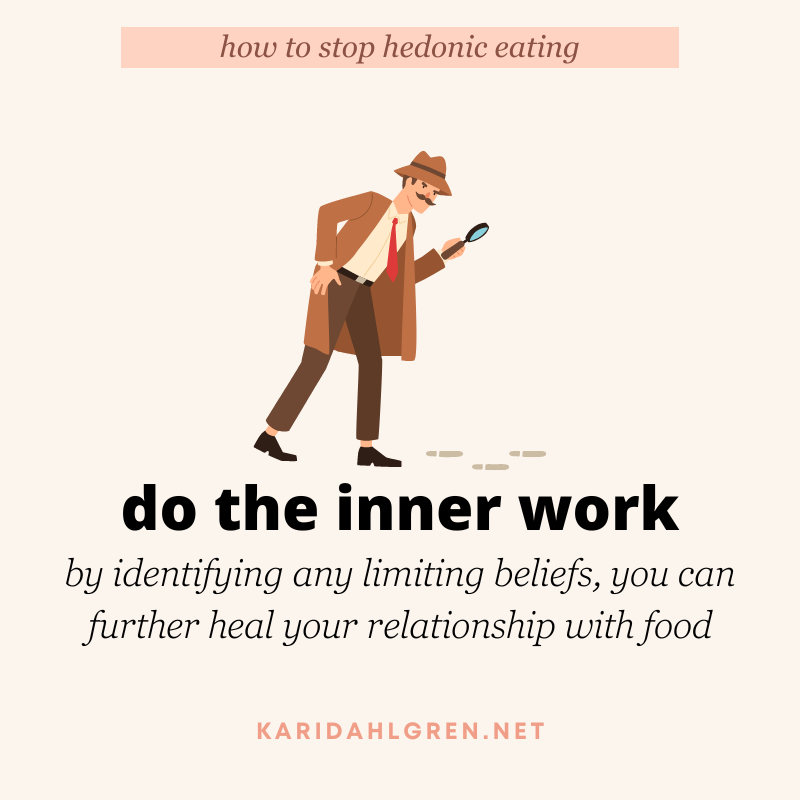
Exploring the science behind hedonic eating has given you key insights into the complex drivers of this behavior. Yet, simply understanding these factors isn’t enough to break free from the cycle of compulsive eating. Real change in how you relate to food involves peeling back even more layers of eating psychology.
This is where my digital workbook, Why We Do the Things We Do, can help. Designed to reveal your subconscious motives behind food-related self-sabotage, this workbook is one of my most popular offerings.
Using a mix of prompts, examples, and introspective exercises, the workbook guides you through the process of identifying and challenging the limiting beliefs that fuel self-sabotage around food. By uncovering these often-hidden beliefs, you gain the clarity needed for healing — after all, we cannot heal what we cannot see.
Navigating Hedonic Eating: A Path to Balanced Pleasure
Remember, hedonic eating isn’t inherently bad. Integrating pleasure into your eating without guilt can enhance your overall eating experience and well-being. The challenge arises when eating becomes compulsive, driving a cycle that feels uncontrollable.
The journey beyond compulsive hedonic eating is not about strict avoidance but understanding and adaptation. By addressing the emotional roots of your eating habits and learning to find joy beyond food, you can transform your relationship with food from one of restraint to one of ease.
And if an easy relationship with food seems like an outlandish goal, I invite you to explore my free resources below. They reveal the next best step towards the ultimate goal of feeling normal around food.
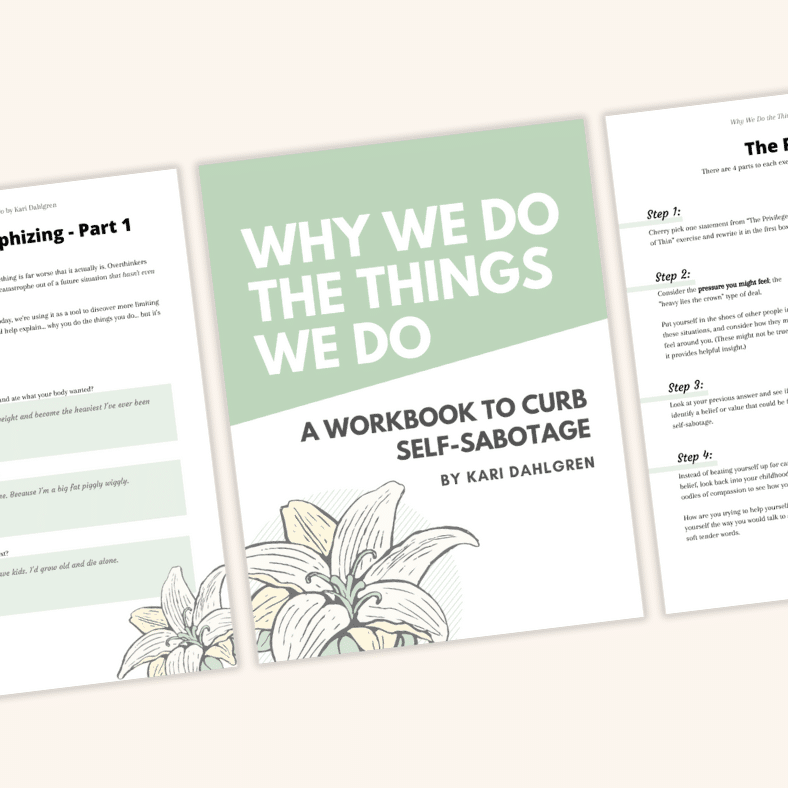
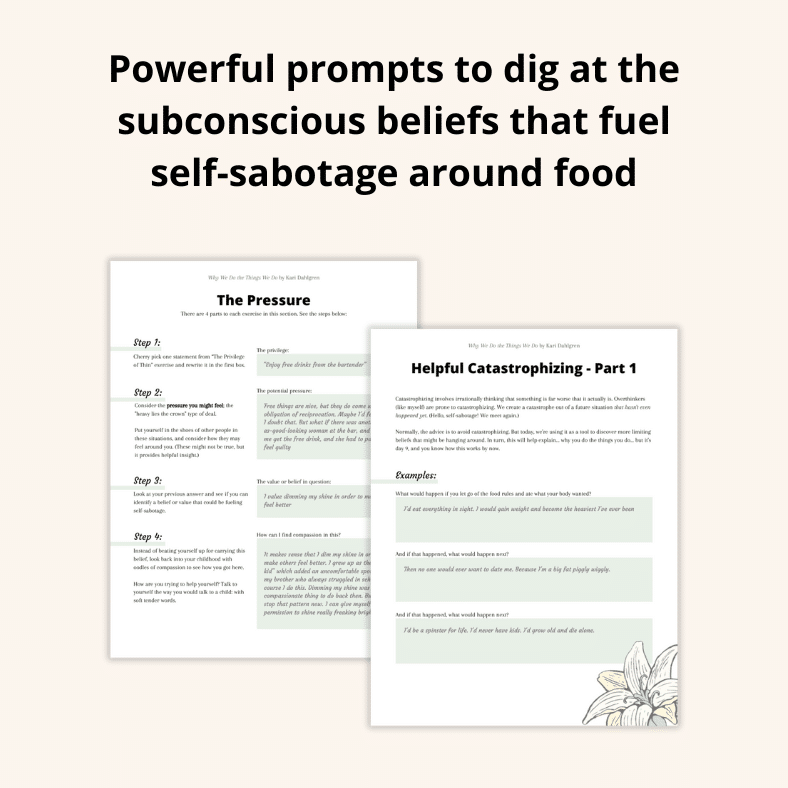
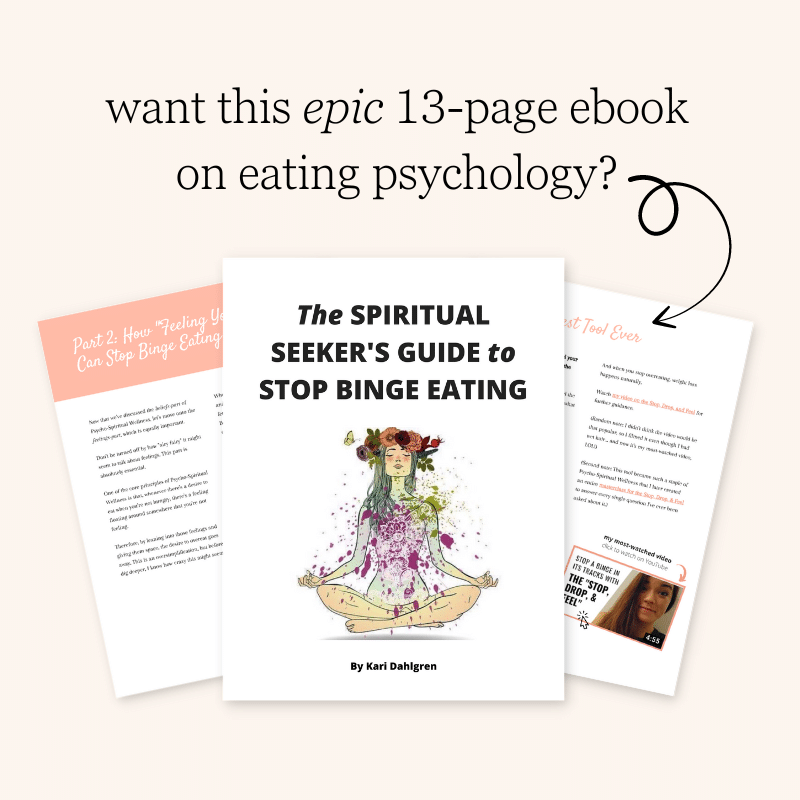
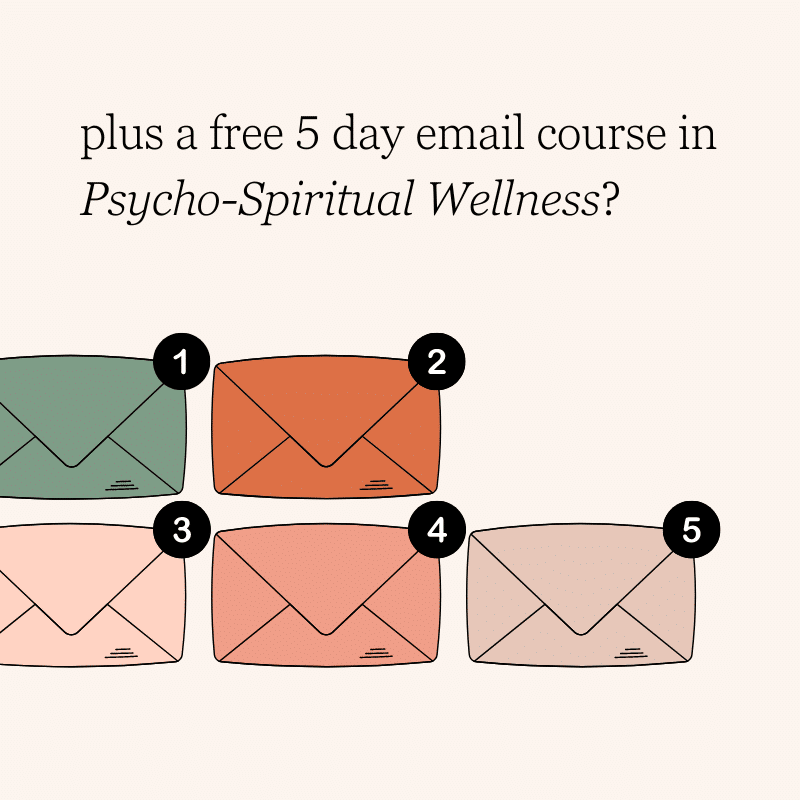
![best seller [cover of Why We Do the Things We Do]](https://karidahlgren-net.b-cdn.net/wp-content/uploads/2023/09/why-we-do-the-things-we-do-1.png)
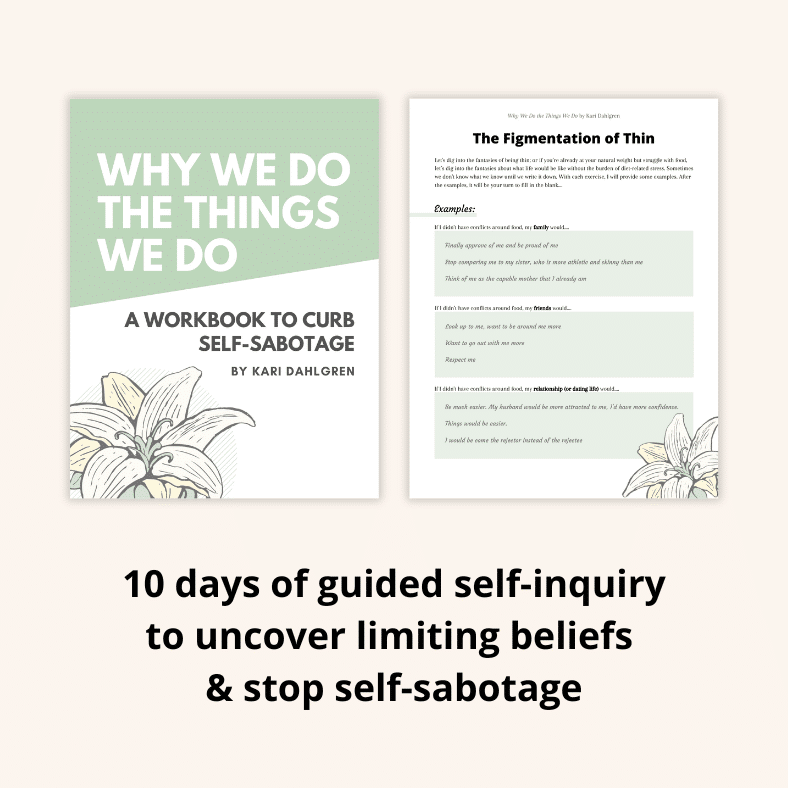
Hello! I’m a binge eater. Overweight, diets not working. I k ow what to do to loose but wont do it. Call it menopause, divorce, depression – what ever – I’m still sick and tired of this weight. I do fine at home it’s when I visit my daughter, mother or at work! I can’t say no to mom, and I stress eat at work.
Thank you for your articles, I’m hoping to change my mind set.
Hi Sandra! Thanks for sharing your story. I think a lot of people can relate to you!! I’d like to hone in on one thing you said here, in case it helps others. Not being able to say no to mom seems like a boundary issue, or an emotional tolerance issue. If you have a loving relationship with your mother, then she should be OK if you say, “No thanks, I’m full. But I love you. Thanks for offering.” If you can’t say that, get curious about why. Is it guilt? Is it shame? Then, can you make space for that feeling? Can you hold space for the discomfort? Also, try having an open conversation with her about how you feel about food. I hope this helps!! xoxo
This does not work at all! Letting yourself have the food leads to binging, plain and simple. Just because it may have worked for you doesn’t mean it works for others. I gained over a hundred pounds by letting myself have unrestricted access.
Thanks for sharing Hayley. I’m sorry things are rough right now. I hope you’re familiar with the eating guidelines and the Stop, Drop, and Feel. Psycho-Spiritual Wellness is a system. Hopefully you’re not cherry picking the permission part and leaving the rest behind. I don’t encourage unrestricted access and that’s all. There’s a lot more that goes into it. Sending you best wishes.
This is so helpful! I’ve been searching for years for something that makes sense and when I read the part about hedonistic eating it made totally sense! I’ve struggled for over 10 years to understand why I eat the way I do and why i pick specific food. I can definetely relate to the need to create joy and I’ve applied for the ebook. Thank you for writing this you have no idea the impact and I’m so grateful x
Thank you so much Kelly! I am sooo glad it helps!
me right now finishing my box of cake while reading this…
The journey starts with self-understanding 😉
I’m finding your insights extremely helpful right now! I’ve tried to be more aware of the feelings, tried not to numb them, and have NOT had to go to stretch pants during this pandemic. Thanks you!
Thanks so much Gale! I’m soooo happy to hear about your progress!! Keep it up 🙂
Hi Kari. I’m loving your content and would love to follow you on IG. However, I don’t get to find your account. Do you have one? How can I find you over there? 🙂
Hi Macarena! Thanks so much for the love! Sadly, I don’t have an IG account for Psycho-Spiritual Wellness. You can catch me on YouTube or, for the best stuff, my Tuesday Newsletters. <3
My dear Kari,
Thank you for changing my life!
After all these years of binge and emotional eating, your articles and the way you justify every subject under discussion, sweetened my sadness and frustration. Your way of thinking is a gift for me.
Stop ,Drop and Feel then !
Thank you,
I wish you all the best.
Love,
Maria.
Hello Maria! Thank you for this beautiful comment. I am glad you’re here! And I hope the SDF continues to help. Keep me posted on your progress!
Kari, thanks for this great article. I had never considered that I might need to find more sources of joy in my life in order to stop overeating. That’s a really fresh take that makes a lot of sense.
Thanks for the comment Shoshana! I hope you’re able to find your joy and get lots of it 🙂
Hi, I’ve been trying to think of what brings me joy, and it’s love. I love my children, and watching them enjoy life brings me joy. I took my daughter to Boston, and took plenty of pictures of her having a good time exploring. Unfortunately, the entire time, I was thinking about food. I wanted to get ice cream. I didn’t do it, but I gazed longingly at every ice cream shop. We ended up stopping for milk tea and I had a frozen avocado milk tea that was pretty much a milk shake. I wanted to stop at every restaurant. I want to put food in my mouth ALL THE TIME even when I’m not hungry. I try to drink a lot of water, and I chew gum, and I get hot beverages like tea, that I can sip on for awhile. I would really like to not have this urge though. It’s eating just because I want the taste of food in my mouth. And it persists even when doing the things that bring me joy.
Hi Angela! I’m sorry to hear about the incessant food noise going on in your head. I’ve been there, and it’s not fun. My recommendation (unsolicited, since you didn’t pose a question, but I can’t help myself) is to focus on the Stop, Drop, and Feel. Since you know what your joy is, then the next step is to look at the feelings that drive the compulsive thoughts around food. I hope this helps!
Hi Kari, Finally! I love your program, wisdom, and approach. I’m 67 and I have been crazy around food for my entire life. Not feeling/eating and hedonic eating have been my MO. Now I’m asking myself what am I trying not to feel right now when I want food and I’m not hungry. It works! I find honoring my body and listening to what it wants, I’m drinking less coffee and wine and more water, I’m taking better care of myself and I’m learning about me every day. Thank you from the depths of my soul.
Thank you Thia 🙂 I really appreciate your kind words, and I am sooo glad you’re gaining all this wonderful insight into yourself. What a gift!! I hope it continues to go well for you. xo
I am really getting so much out of your content. I’ve tried “mindful eating” before and it didn’t work for me. Your approach makes so much more sense. It’s the emotional component that was missing for me. Also, the hedonistic eating concept really resonates with me. I can see how food is filling that “hole” in my busy life. I totally feel like I’ve been getting skunked out of the good things in life. Wow. I may have mentioned in a comment somewhere else before, but I’m in my late 50’s and have never heard such a simple, direct, and thoroughly explained way that makes total sense. I know, easier said than done. However, I got rid of all my diet stuff and I am all in. Thanks so much!!
Hi again Dolores! Thank you sooo much for your kind words. I’m so glad you’re getting good use from the content 🙂 Hurray for being all in! I hope you’ll reply to one of my emails sometimes so that we can connect even more. xo
I find this very intriguing and I hope I can make it successful.
I want to know how one knows when they’re full? When it’s enough? I can eat non stop.
Thank you for the food for thought.
Hi Brenda! Great question. Can you tell when you’re physically full? Even if you can keep eating, is there a point when you know you’ve physically had enough? If not, don’t worry. For many of us, it takes time to get back in touch with hunger/fullness. Don’t give up and keep trying to lean into your intuition <3
What happens when you are unable to identify what drives the urge to eat? Or, worse yet, name something that brings joy?
Such a deep comment! Sometimes there are other emotions underneath the joy, like fear. When many of us experience joy we may also experience fearful thoughts like ‘it’s only a matter of time before the other shoe drops.’ I’d love to know if this resonates with you or not <3
Hey Kari – this one really spoke to me. Just discovered you can *bake your own bread* and then eat it warm from the oven?!?!? Talk about eating past fullness and definitely hedonic eating going on. Thanks to your quizzes, I know this is my binge style, so this article was quite timely. I’m currently making a list of all the other “hedonic” things I enjoy doing and am going to start doing one a day and see what happens. So much appreciation for your good work!
Yeeeessss Molly!!! So good!! I love that you’re making a list of other non-food things that bring you joy 🙂 keep me posted! I want to hear how it goes. And I hope you’ll continue to enjoy the warm bread when you’re hungry. It sounds too good to stop! xo
Kari, this blog is another one of the 10,000 reasons why I love you so much. You are speaking to my SOUL with this one. I actually shared it with several family members too. Thank you, thank you.
Yeeeeessss!! Thank you Shannon! It is so good to hear from you!! To any of Shannon’s family members perhaps reading this, hey hi hello ^_^
Hi! I was diagnosed with depression and anxiety a year and a half ago. Before then, I was in the best shape of my life and really thriving. As soon as my depression hit, it was over. I gained and gained because I simply tried desperately to feel something. I am and have been medicated since, but my eating is the only thing really dragging me down. I’ve been trying loose meal prep with lots of vegetables and it’s improved for sure. I found this and it helped me even further to understand what’s going on with me. Thank you for your time and effort in sharing this for us. I appreciate you.
I am so glad this was helpful Tyrone! Self-understanding can pave the way for so much healing, and it means a lot to me to be able to provide that. Keep on 🙂